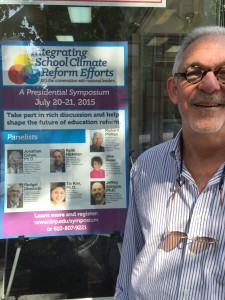My Experience at IIRP’s Integrating School Climate Reform
One of the most enjoyable, rewarding parts of my work is providing training for school personnel. I believe in professional development and care deeply about serving those that care for our young people. I’ve had the pleasure of working with lots of schools, districts and community organizations as well as lots of different programs these last 30 years. A constant question throughout the years from educators is “How do we coordinate all these initiatives we implement with any degree of success? There are so many programs and we can’t do another one.” I share their concerns!
In July, I had the privilege of serving as a panel member at a symposium sponsored by the International Institute for Restorative Practices (IIRP). This was a first: a gathering of 150 plus school and community leaders from across the United States committed to working together with the dual purpose of learning from each other and how to consider integrating frameworks for the improvement of school climate efforts. Panel members included leaders from nationally and internationally evidence-based programs and practices; Jeff Sprague, Positive Behavior Intervention Supports, Tia Kim the Committee for Children (Second Step and Steps to Respect), Rick Phillips, Safe Ambassador Program, Jane Riese, Olweus Bullying Prevention Program, Jonathan Cohen, National School Climate Center, Keith Hickman, IIRP, and yours truly representing STARS Student Assistance Programs.
A Snapshot of School Climate Discussion
IIRP hosted this first of its kind symposium entitled, “Integrating School Climate Reform Efforts”. A small group discussion format based on the civic engagement work of Peter Block was facilitated by dear friend and colleague, Lee Rush (certified trainer). CEO of IIRP, John Bailie, spearheaded the initiative. After brief presentations from panel members the entire group participated in circles, the cornerstone of restorative practices, and discussed topics related to how best to address issues of school climate from a very broad perspective. The process was powerful and there were great moments of insight captured for future discussion and possible action steps.
While the intent of the symposium was not to reach consensus about an overall strategy to integrate and coordinate all these or for that matter, any of the hundreds of efforts across the country, the conversations stimulated tremendous thought and generated many possibilities. This was no simple, single event attempt to solve all the issues related to integration of programs, services and frameworks. It was a purposeful, thoughtful conversation. Some of the next steps will include the development of a “white paper” outlining findings and key observations from the symposium.
Endless Possibilities for Collaboration and Integration
I believe I’d be correct in stating that one of the greatest benefits, personally and professionally, was the interactions and development of relationships with members of the panel and participants. Many of the panel members had never met individually, or spent this amount of time learning from one another. The future meetings and conversations that will result from this first gathering will no doubt bring about possibilities for collaboration and integration. It was a powerful opportunity to begin a very important conversation to address the question from many educators.
“How do we work all these efforts together?”
Read about the Restorative Works Learning Network recap of IIRP Symposium: Integrating School Climate Reform Efforts blog post.



